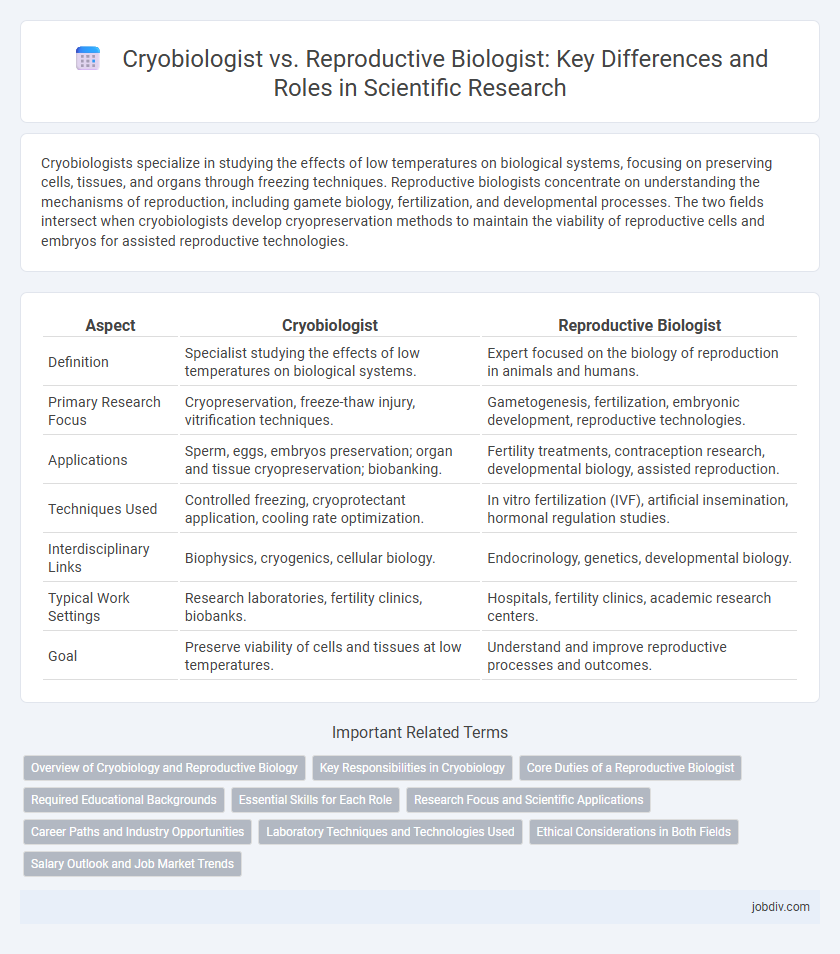Cryobiologists specialize in studying the effects of low temperatures on biological systems, focusing on preserving cells, tissues, and organs through freezing techniques. Reproductive biologists concentrate on understanding the mechanisms of reproduction, including gamete biology, fertilization, and developmental processes. The two fields intersect when cryobiologists develop cryopreservation methods to maintain the viability of reproductive cells and embryos for assisted reproductive technologies.
Table of Comparison
| Aspect | Cryobiologist | Reproductive Biologist |
|---|---|---|
| Definition | Specialist studying the effects of low temperatures on biological systems. | Expert focused on the biology of reproduction in animals and humans. |
| Primary Research Focus | Cryopreservation, freeze-thaw injury, vitrification techniques. | Gametogenesis, fertilization, embryonic development, reproductive technologies. |
| Applications | Sperm, eggs, embryos preservation; organ and tissue cryopreservation; biobanking. | Fertility treatments, contraception research, developmental biology, assisted reproduction. |
| Techniques Used | Controlled freezing, cryoprotectant application, cooling rate optimization. | In vitro fertilization (IVF), artificial insemination, hormonal regulation studies. |
| Interdisciplinary Links | Biophysics, cryogenics, cellular biology. | Endocrinology, genetics, developmental biology. |
| Typical Work Settings | Research laboratories, fertility clinics, biobanks. | Hospitals, fertility clinics, academic research centers. |
| Goal | Preserve viability of cells and tissues at low temperatures. | Understand and improve reproductive processes and outcomes. |
Overview of Cryobiology and Reproductive Biology
Cryobiology explores the effects of low temperatures on biological systems, emphasizing cellular preservation and freezing techniques to maintain viability during storage and thawing. Reproductive biology studies the physiological and molecular mechanisms governing reproduction, including gametogenesis, fertilization, and embryonic development. Both fields intersect in assisted reproductive technologies, where cryopreservation of gametes and embryos plays a critical role in fertility treatments and research.
Key Responsibilities in Cryobiology
Cryobiologists specialize in studying the effects of low temperatures on biological systems, focusing on the preservation of cells, tissues, and organs through techniques such as cryopreservation and vitrification. Their key responsibilities include optimizing freezing and thawing protocols to maintain cell viability, investigating cryoprotectant toxicity, and improving storage methods for long-term biobanking. In contrast, reproductive biologists primarily investigate reproductive processes, fertility, and developmental biology, often utilizing cryobiological methods as tools rather than their central focus.
Core Duties of a Reproductive Biologist
Reproductive biologists specialize in studying the mechanisms of reproduction, including gamete development, fertilization, and embryonic growth to enhance fertility treatments and animal breeding programs. Their core duties involve conducting experiments on reproductive cycles, analyzing hormonal influences, and developing assisted reproductive technologies such as in vitro fertilization (IVF). In contrast, cryobiologists primarily focus on preserving biological samples, emphasizing the effects of low temperatures on cells and tissues to optimize cryopreservation techniques.
Required Educational Backgrounds
Cryobiologists typically require advanced degrees in biology, biochemistry, or related fields, often obtaining a Ph.D. to specialize in the effects of low temperatures on biological systems, including cellular preservation techniques. Reproductive biologists usually hold degrees in biology, reproductive physiology, or biomedical sciences, with many pursuing master's or doctoral programs focused on fertility, embryology, and reproductive health. Both fields demand rigorous training in laboratory techniques and experimental research, emphasizing molecular biology and biotechnological methods tailored to their specialized study areas.
Essential Skills for Each Role
Cryobiologists require expertise in low-temperature physics, cryopreservation techniques, and cellular response to freezing injury to successfully preserve biological samples. Reproductive biologists must possess deep knowledge of endocrinology, embryology, and assisted reproductive technologies to study and manipulate reproductive systems effectively. Both disciplines demand strong laboratory skills, analytical thinking, and proficiency in microscopy and molecular biology techniques.
Research Focus and Scientific Applications
Cryobiologists specialize in the study of biological materials at low temperatures, focusing on preserving cells, tissues, and organs through cryopreservation techniques to enhance long-term storage and viability. Reproductive biologists concentrate on understanding reproductive systems, fertility mechanisms, and developmental processes to improve assisted reproductive technologies such as IVF. Research in cryobiology advances transplantation medicine and biodiversity conservation, while reproductive biology drives innovations in fertility treatments and developmental biology.
Career Paths and Industry Opportunities
Cryobiologists specialize in the study of biological materials at low temperatures, focusing on preserving cells, tissues, and organs, which opens career opportunities in biomedical research, fertility clinics, and pharmaceutical industries. Reproductive biologists concentrate on the mechanisms of reproduction and development, offering roles in fertility treatment centers, genetic counseling, and animal breeding industries. Both fields intersect in assisted reproductive technologies but diverge in applications, with cryobiologists emphasizing preservation techniques and reproductive biologists focusing on reproductive health and development.
Laboratory Techniques and Technologies Used
Cryobiologists specialize in techniques such as vitrification, controlled-rate freezing, and cryopreservation to maintain biological samples at ultra-low temperatures, utilizing cryostats and liquid nitrogen storage systems. Reproductive biologists employ assisted reproductive technologies (ART) like in vitro fertilization (IVF), intracytoplasmic sperm injection (ICSI), and embryo culture, often incorporating micromanipulation tools and time-lapse imaging systems in laboratory protocols. Both fields rely heavily on advanced microscopy, precise temperature control, and sterile environments to optimize sample viability and experimental outcomes.
Ethical Considerations in Both Fields
Cryobiologists and reproductive biologists face distinct ethical considerations involving the preservation and manipulation of biological materials, such as embryos and gametes, requiring strict adherence to consent and long-term storage guidelines. Issues like the potential for misuse, biosecurity risks, and the impact on future generations place significant responsibility on cryobiologists, while reproductive biologists confront ethical dilemmas related to genetic selection, embryo implantation, and accessibility of reproductive technologies. Both fields must balance scientific advancement with respect for human rights, regulatory compliance, and societal implications to maintain ethical integrity.
Salary Outlook and Job Market Trends
Cryobiologists specializing in low-temperature preservation techniques often command higher salaries, averaging $75,000 to $110,000 annually, due to their niche expertise in fields such as organ preservation and cryopreservation of biological samples. Reproductive biologists typically earn between $60,000 and $90,000, reflecting broader job opportunities in fertility clinics, agriculture, and developmental biology research. The job market for cryobiologists is growing steadily with advancements in cryopreservation technology, while reproductive biologists benefit from ongoing demand in healthcare and agricultural biotechnology sectors.
Cryobiologist vs Reproductive Biologist Infographic

 jobdiv.com
jobdiv.com